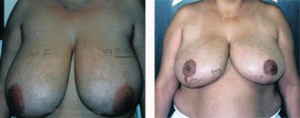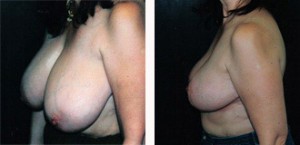GIGANTOMASTIA TREATMENT
Posted On: January 23, 2013 Author: The Office of Dr. Stuart Linder Posted In: Breast Reduction, Breast topics
Patients from all over come to Beverly Hills to have their breast reduction performed with Dr. Linder. The breast reduction procedure involves removing skin, fat and glandular tissue. The normal breast is composed of 50% fat and 50% glandular tissue. When patients have an excessive amount of fat, breast tissue and skin, they may have bilateral breast hypertrophy or if enormous breasts arise, they may be called “gigantomastic breasts.”
Breast reduction procedures are usually performed using the Wise-pattern technique which is an anchor scar where dermoglandular tissue is removed both in the medial and lateral breast and the nipple areolar complex on the inferior pedicle is superiorly retropositioned.
The scarring is significant and the scar is a Wise-pattern or an anchor scar. With this in Dr. Linder’s hands leads to maintaining good blood supply to the nipple areolar complex to prevent devascularization or problems with loss of death of the nipple.
Often, breast reductions require suction lipectomy of the lateral breast, removing tissue from the axillary tail-of-Spence. When the lateral breast is quite full and this is not suctioned, the women often complain of inability to bring their arms down to the sides of their chest without constant heaviness and fullness to the sides.
Patient symptoms with breast reductions usually include severe back pain, neck strain, grooving from the shoulder blades from the bra straps, and rashes (intertrigo) along the inframammary folds associated with hygienic contact dermatitis or infections.
They do well with the breast tissue removed from the inner breast as well as a drainage tube placed for 24 to 48 hours. Sutures usually remain for up to 21 days. A lot of tension occurs along the incision sites due to bringing these flaps tightly into the midline. The newer technique, the Lejour technique, is a technique where a lollypop scar is made without the inframammary fold scar. Usually, tissue is removed as a central glandular resection without the inframammary fold. We, however, prefer to use the Wise-pattern or the anchor scar.

